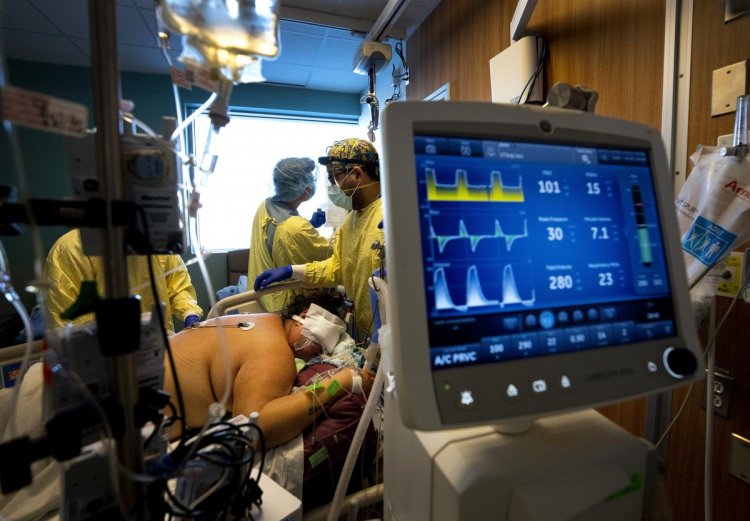Ontario hospitals seeing rise in numbers of staff testing positive for COVID
Ontario hospitals are reporting a rise in numbers of staff who have tested positive for COVID-19, and in one case — at Kingston Health Sciences Centre — the number of absences due to the virus is the highest since the pandemic began.KHSC, the University Health Network and the Ottawa Hospital all confirmed an increase of COVID-19 infections among staff in recent weeks.Experts say the increase in cases among health-care professionals is an indicator of a rise in community infections as the group is among a small number of the population who are eligible for publicly funded PCR tests, since access was sharply restricted at the end of December due to the Omicron surge. The increase comes after Ontario relaxed COVID restrictions, lifting capacity limits and proof-of-vaccination requirements March 1, and mask mandates this past Monday.Numbers from Kingston Health Sciences Centre showed that staff absences on Thursday due to COVID surpassed numbers in January, at the height of the Omicron wave. Dr. Gerald Evans, head of infectious diseases at KHSC, said these were the highest absences due to COVID recorded since the beginning of the pandemic, and they were primarily among staff that provide direct care to patients.Around 140 staff at KHSC were absent due to COVID on Thursday, roughly 35 per cent higher than the last peak on Jan. 14, when 104 absences were recorded. Numbers are likely higher as current figures do not include staff who are currently isolating because a household member tested positive, Evans said, adding that absentee rates are above and beyond the usual non-COVID-related absences.In Toronto, a UHN spokesperson said they were also witnessing an uptick. In February, as the Omicron wave began to ease, a rolling average of 10.6 per cent of staff reporting possible symptoms tested positive for COVID. At the beginning of March, the rolling average was 6.8 per cent. By mid-March it was 14 per cent. On Friday 27.2 per cent of staff reporting possible COVID symptoms were positive.A spokesperson from the Ottawa Hospital did not provide data but confirmed an increase in the number of staff isolating at home due to COVID-19 illness or exposure, specifically in the last few weeks.The Star asked the Ontario Ministry of Health directly for weekly data on COVID infections among health-care workers, which it did not provide. But using ministry situation reports provided by CUPE, we found that as of Dec. 15, 25,337 health sector workers had tested positive for COVID. Three months later, as of March 24, that number had ballooned to 41,191 – a 62.5 per cent increase over that time period, meaning a large chunk of health sector workers were infected during the Omicron wave alone.At the end of December, testing was restricted largely to high-risk individuals and health-care workers. With limited testing capacity, the province’s daily COVID case counts no longer paint an accurate picture of community spread. Instead, key indicators include wastewater surveillance, hospitalization, ICU and test positivity rates to determine community spread.“There is no question that this is an indication of community spread — health-care workers are a bellwether for what is going on,” said Colin Furness, an infection control epidemiologist at the University of Toronto.It is unlikely that health-care workers are being infected at work, as safety protocols remain stringent in hospitals while PPE and masking policies are still in place, Furness said.“If a small portion of the population is getting PCR-tested and if there is an increase of infection among that group, it is reflective of the community spread,” Furness said.Dr. Raghu Venugopal, an emergency room physician in Toronto, said the increase of COVID infections among his colleagues over the last week is concerning.After a brief drop in cases following the Omicron wave, Venugopal, who works in several emergency departments, said he has witnessed a resurgence of COVID cases among health-care workers in March.“I’m seeing a lot of health-care workers in multiple specialties and disciplines, who qualify for PCR testing, falling sick because of COVID, even in the last week,” Venugopal said.Venugopal said the rise in numbers in Ontario was expected as mandates were lifted and that hospitals have established strong contingency plans throughout the pandemic for when health-care workers fall ill. But he urged people to continue to practise caution to prevent another wave and unnecessary strain on the health-care system.Evans in Kingston said that hospitals were already feeling the impacts of policy changes and that the number of health-care workers falling ill with COVID is a good reflection of that stress.“It’s really messing around with our staffing because there are lots of people who still need care who don’t have COVID,” Evans said. “These infections correspond with the removal of public health measures. It’s a metric that’s really flying under the radar and we should be looking at it in


Ontario hospitals are reporting a rise in numbers of staff who have tested positive for COVID-19, and in one case — at Kingston Health Sciences Centre — the number of absences due to the virus is the highest since the pandemic began.
KHSC, the University Health Network and the Ottawa Hospital all confirmed an increase of COVID-19 infections among staff in recent weeks.
Experts say the increase in cases among health-care professionals is an indicator of a rise in community infections as the group is among a small number of the population who are eligible for publicly funded PCR tests, since access was sharply restricted at the end of December due to the Omicron surge. The increase comes after Ontario relaxed COVID restrictions, lifting capacity limits and proof-of-vaccination requirements March 1, and mask mandates this past Monday.
Numbers from Kingston Health Sciences Centre showed that staff absences on Thursday due to COVID surpassed numbers in January, at the height of the Omicron wave. Dr. Gerald Evans, head of infectious diseases at KHSC, said these were the highest absences due to COVID recorded since the beginning of the pandemic, and they were primarily among staff that provide direct care to patients.
Around 140 staff at KHSC were absent due to COVID on Thursday, roughly 35 per cent higher than the last peak on Jan. 14, when 104 absences were recorded. Numbers are likely higher as current figures do not include staff who are currently isolating because a household member tested positive, Evans said, adding that absentee rates are above and beyond the usual non-COVID-related absences.
In Toronto, a UHN spokesperson said they were also witnessing an uptick. In February, as the Omicron wave began to ease, a rolling average of 10.6 per cent of staff reporting possible symptoms tested positive for COVID. At the beginning of March, the rolling average was 6.8 per cent. By mid-March it was 14 per cent. On Friday 27.2 per cent of staff reporting possible COVID symptoms were positive.
A spokesperson from the Ottawa Hospital did not provide data but confirmed an increase in the number of staff isolating at home due to COVID-19 illness or exposure, specifically in the last few weeks.
The Star asked the Ontario Ministry of Health directly for weekly data on COVID infections among health-care workers, which it did not provide. But using ministry situation reports provided by CUPE, we found that as of Dec. 15, 25,337 health sector workers had tested positive for COVID. Three months later, as of March 24, that number had ballooned to 41,191 – a 62.5 per cent increase over that time period, meaning a large chunk of health sector workers were infected during the Omicron wave alone.
At the end of December, testing was restricted largely to high-risk individuals and health-care workers. With limited testing capacity, the province’s daily COVID case counts no longer paint an accurate picture of community spread. Instead, key indicators include wastewater surveillance, hospitalization, ICU and test positivity rates to determine community spread.
“There is no question that this is an indication of community spread — health-care workers are a bellwether for what is going on,” said Colin Furness, an infection control epidemiologist at the University of Toronto.
It is unlikely that health-care workers are being infected at work, as safety protocols remain stringent in hospitals while PPE and masking policies are still in place, Furness said.
“If a small portion of the population is getting PCR-tested and if there is an increase of infection among that group, it is reflective of the community spread,” Furness said.
Dr. Raghu Venugopal, an emergency room physician in Toronto, said the increase of COVID infections among his colleagues over the last week is concerning.
After a brief drop in cases following the Omicron wave, Venugopal, who works in several emergency departments, said he has witnessed a resurgence of COVID cases among health-care workers in March.
“I’m seeing a lot of health-care workers in multiple specialties and disciplines, who qualify for PCR testing, falling sick because of COVID, even in the last week,” Venugopal said.
Venugopal said the rise in numbers in Ontario was expected as mandates were lifted and that hospitals have established strong contingency plans throughout the pandemic for when health-care workers fall ill. But he urged people to continue to practise caution to prevent another wave and unnecessary strain on the health-care system.
Evans in Kingston said that hospitals were already feeling the impacts of policy changes and that the number of health-care workers falling ill with COVID is a good reflection of that stress.
“It’s really messing around with our staffing because there are lots of people who still need care who don’t have COVID,” Evans said. “These infections correspond with the removal of public health measures. It’s a metric that’s really flying under the radar and we should be looking at it in terms of health-care stress.”
This comes as other COVID indicators are suggesting a resurgence of cases. There have been reports of outbreaks at long-term-care facilities and Ontario’s COVID-19 wastewater signal is showing a steady increase, with numbers currently doubling every seven days.
Dr. Peter Jüni, the scientific director of Ontario's science table, said a resurgence of cases is certain but how large it will be determined by public behaviour.
“There is an exponential growth and right now it looks as if the concentration in wastewater is doubling every seven days. This is directly correlated with case counts,” Juni said.
“We need to make sure we slow this down, and this can be achieved through our behaviour. Right now, we have 25,000 infections and we just need make sure things stay under control.”
Ghada Alsharif is a Toronto-based staff reporter for the Star. Reach Ghada via email: galsharif@torstar.ca




















